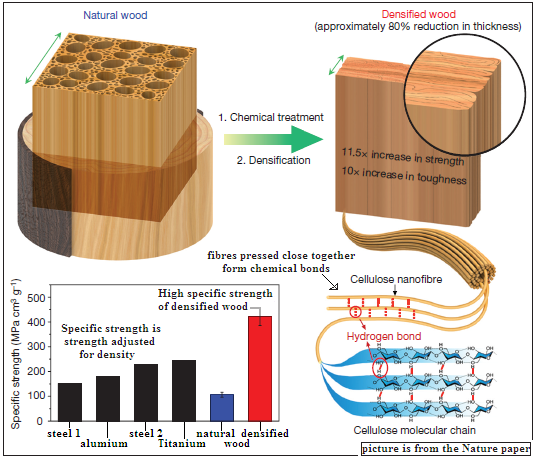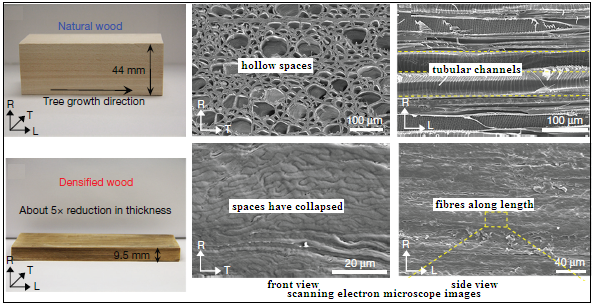Wood flexes its fibres
-S.Anantanarayanan
The expansion of civil work and tall structures in modern times is a result of the variety of shapes that we are able to create with cement and concrete and the enormous strength that concrete can have when it is reinforced by steel bars, says S.Ananthanarayanan.
The use of cement and steel, and even plastics which have now appeared, however, involves huge energy input and carbon emission in their production. In contrast, the use of wood as the main building material in earlier times was eco-friendly, even if wood,
as a material, has less strength and durability. A technique to process wood to grow many times in strength and resilience, even higher than other materials, would hence be of great interest.
Jianwei Song, Chaoji Chen, Shuze Zhu, Mingwei Zhu, Jiaqi Dai, Upamanyu Ray, Yiju Li, Yudi Kuang, Yongfeng Li, Nelson Quispe, Yonggang Yao, Amy Gong, Ulrich H. Leiste, Hugh A. Bruck, J. Y. Zhu, Azhar Vellore, Heng Li, Marilyn L. Minus, Zheng Jia, Ashlie
Martini, Teng Li and Liangbing Hu, of the University of Maryland, Northwestern University, University of California at Merced and the Forest Products Laboratory, Wisconsin, report in the journal, Nature, a method to compress natural wood and make it stronger,
weight for weight, than steel.
The strength of materials arises mainly from the strength of the atom-level bonding between the microscopic components of the material. Denser materials, whose composant units are closer packed, would hence be stronger, and this is true in the transition
from the less-dense wood, an organic material, to denser cement, which is composed of minerals, and then to the densest, the metals. In the case of wood, its structure has evolved specifically to include channels for water and nutrients and to have strength
only enough to support the weight of the tree. Wood thus contains voids, has low density and little capacity to withstand a crushing load. However, as it has fibres that run along the direction of growth, which help a tree withstand high winds, wood can tolerate
bending or stretching forces. This is the property that has made wood useful in constructing beams that support the floors or the roof of a building. Very tall structures made of wood, however, have not been possible.
Cement and concrete, in contrast, have high compression strength and can work as the supports for beams, which, as cement and concrete cannot bear bending or stretching, have necessarily been of wood. Steel, however, has high compressive strength as well
as the capacity to resist bending, a capacity that is called tensile strength. While steel structures, like some bridges or the Eifel Tower, could hence be very strong, metals have high density (steel is 7.5.to 8 gms per cc) and add to the weight of the structure.
The weight tends to limit how high any structure can be.
Reinforced concrete is a mixture of cement, sand and gravel that contains steel rods that that bind firmly to the cement. While concrete can bear compression, the steel rods provide the capacity to bear bending forces and the combination has great strength,
although only part of its volume is steel. The production of both cement and steel, however, uses energy and causes pollution.
Special plastics and petroleum-based substances have also found application as building material, especially when given tensile strength by reinforcement by glass fibre. Even with plastics, however, the financial and environment costs are high and do not
allow these materials to be widely used.
Coming back to wood, we have noted that a reason for its limitations is that it is not dense and its structure has voids. A method to remedy this has been by steam treatment and compression. This class of methods, so far, the authors of the paper in Nature
say, does not eliminate the voids completely. While there is improvement in strength, the result is not durable, particularly in response to humidity. The authors discuss the structure of wood, as containing tubular channels, whose cells consist mostly of
cellulose, along with material called hemicelluloses and lignin. Cellulose is a long chain molecule, thousands of units long, and contributes to the tensile strength of wood. Hemicellulose has little strength to contribute and lignin helps in structural stability.
When wood is chemically treated, there is great reduction of hemicelluloses and lignin but the cellulose largely remains. This reduction makes the cell walls porous and less rigid. As a result, on hot-pressing, the tubular structures and the cell walls collapse
and wood can be compressed down to 20% of the original thickness, with a three-fold increase in density.

" The fully collapsed wood cell walls are tightly intertwined along their cross-section and densely packed along their length direction,” the paper says .And at a finer scale, the cellulose nano-fibres are aligned and also densely packed. This increases
the area of contact between neighboring nano-fibres and promotes chemical bonds to form, which leads to some ten times higher mechanical strength of densified wood, the paper says. A record high tensile strength of densified wood is 587 MegaPascals, which
is greater than that of structural steel (400-550 MPa), the paper says.

While densified wood attains high mechanical strength along the direction of alignment of cellulose nano-fibres, the authors laminated two layers of natural wood with the orientation of wood fibres crossed and then carried out the process of leaching and
hot compression. The result was a composite which showed high tensile strength (~ 225MPa) in both directions, the paper says. Densified wood has also shown good performance in toughness, impact resistance and in high humidity, the paper says. Wood could hence
become a viable alternative material for structural members, even for containers or other areas where metals are used.
While it is possible that wood could take the place of steel in many applications, one could also say that this would lead to increased felling of trees and put pressure on forests. This question could be put in context by considering that the manufacture
of a kilogram of pig iron takes about half a kg of coke and emits about two kg of CO2. An average tree fixes some 1100 kg of CO2 in a lifetime. The loss of a tree could thus be acceptable if it led to saving about 55 kg of steel, which appears to be feasible.
Another aspect is that 1100 kg of CO2 emission is avoided as soon as 55 kg of steel is replaced by the wood from one tree, whereas the tree would take many years to fix the same CO2. And then, the tree could be replanted!
The process reported in the Nature paper should set architects and designers thinking about ways to adapt to greener materials.
------------------------------------------------------------------------------------------
Do respond to : response@simplescience.in